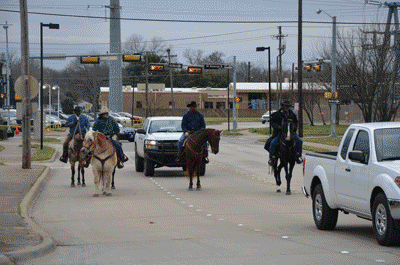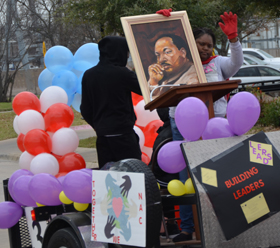Photos by Mark Harkins
Parade participants and attendees braved the cold to celebrate the life of Dr. Martin Luther King, Jr. Saturday, Jan. 16. Elected officials, area church representatives and other nonprofit organizations, high school bands, youth groups and others marched in the MLK Parade which started on Diary Road and ended at the Granville Arts Center.
Martin Luther King, Jr. was born Michael King, Jr., Jan. 15, 1929, to Michael King Sr. and Alberta Williams King. Both father and son adopted the name of Martin Luther to honor the German Protestant minister and religious leader.
He grew up watching his father fight racial prejudice and learned that an attitude of superiority of any class or race was wrong according to God. However, the younger King had no intention of entering the ministry until his junior year at Morehouse College when he took a Bible class. After college graduation he attended Crozer Theological Seminary and graduated at the top of his class.
He met Coretta Scott, who would become his wife, while working on his doctorate at Boston University. He accepted a position as minister at Dexter Av enue Baptist Church in Montgomery, Ala. as he worked on his dissertation and he earned his Ph.D. at the age of 25.
enue Baptist Church in Montgomery, Ala. as he worked on his dissertation and he earned his Ph.D. at the age of 25.
He was selected to lead the historic citywide bus boycott in Montgomery after Rosa Parks was arrested for not surrendering her bus seat to a white man. Additionally, MLK Jr. was one of the 60 ministers who founded the Southern Christian Leadership Conference which organized black churches against racism and planned non-violent civil rights protests.
The young minister brought renewed enthusiasm, excitement and strength to the fight for racial equality. He gave speeches and lectures nationwide but none more memorable and beloved than his “I Have a Dream” speech Aug. 28, 1963. The speech was given at the Lincoln Memorial to more than 200,000 people.
“I have a dream that my four children will one day live in a nation where they will not be judged by the color of their skin but by the content of their character.” — Martin Luther King, Jr. / “I Have A Dream” speech
Progress in the civil rights movement was slow and in 1965, a march from Selma, Ala. to Montgomery, Ala. became violent as police officers used nightsticks and tear gas against protestors as they tried to cross the Edmond Pettus Bridge. Almost 20 protestors were hospitalized from injuries sustained in the clash with the police.
King was not present at that march, but at the next one, when he and a group of demonstrators tried to cross the same bridge, they were met with barricades and state troopers. King instructed his followers to kneel in prayer and remain non-violent. Soon after, in part because of support gained due to the group’s action on the bridge, the Voting Rights Act of 1965 was passed.
He received numerous awards and honors and was named “Time” magazine’s Man of the Year in 1963. At 35, he became the youngest man in history to receive the Nobel Peace prize and donated the prize money, more than $50,000, to the civil rights movement. King gave more than 2,500 speeches and wrote five books and numerous articles.
Experiencing indescribable hardships such as arrests, assaults, personal abuse and the bombing of his home, King courageously did more to further the cause of equality than anyone in history.
He was assassinated in Memphis, Tenn. April 4, 1968.


